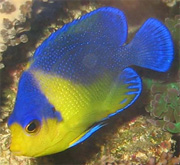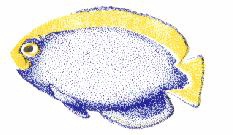|
THE BOTTOM AND JUST PLAIN WEIRD
By. Jim Wolf MS. Marine Biology
Lots of fish live on the bottom. It is a popular place. You can
hide from your enemies, ambush prey, and keep your caloric demands at a
minimum as your rest on the bottom. As a result of this popularity a number
of different groups of fishes have adopted this plan.
They are all usually have a slow metabolism and this means they need
very little food. You should feed them about once a week, and insure that
they get some of the food (such as crustaceans and fish) since these fish
are not too competitive. Supply them with a tank with a few inches
of gravel to bury themselves, and watch their tank mates closely. Many
fish will pick on them and small fish may be on the menu, so pick their
tank mates wisely. A tempting live food will start them feeding.
There are roughly six groups that are in this group, so lets have a
look at them ;
BATRACOIDIFORMES. This group has one common family (Batrachoididae),
with about 12 genera and 50 plus species. They are very uncommon, with
the fresh water lion fish (Batrachomeus) and the odd Sanopus
(rarely seen). They are ambush predators and so they bury themselves in
the sand and wait for food to come by. A biweekly feeding of some
meaty whole food (shrimp, clam, fish, etc.) is preferred as too much food
may cause digestion problems. They have strong spines so be wary, and don't
be surprised if the make noise. These animals can contort their swim bladder
to make pronounced grunting noises!
LOPHIIFORMES. An order that includes a lot of different fishes
that possess a modified dorsal fin. The first spine on the dorsal fin is
modified into a movable "lure". The fish then remains motionless attracting
prey by fishing with the lure. They usually will therefore only eat live
foods such as fish and crustaceans, but can be trained to eat prepared
food. Use a feeding tongs, and a little bit of starvation to get them going.
Feed them about twice week. Two families are seen in the order. The Lophiidae
includes the goosefish. This is voracious predator lies buried in the sand,
and resembles a Cheshire Cat with an ominous toothy grin. The other family
in this group are the anglerfishes (Antennariidae). They come in
a variety of colors and textures to blend in with the colorful coral reef.
Their pectoral and pelvic fins are used to crawl over the substrate as
they sneak up on their prey. Their appetite is enormous, and any fish less
than two thirds their size might be eaten. A well established aquarium
wit lots of rock to hide among is required. Insure that they get some food,
as they are not too competitive. A last hint. Do not remove them from the
water. If removed, the fish may gulp air and it is difficult for the fish
to rid itself of this air bubble!
The final three groups are bottom dwellers that enjoy a diet of crustaceans
and worms. They are very interestingly shaped, all modified to exploit
life on the bottom.
The Sea Robin (Triglidae), and the Flying Gunards (Dactylopteridae)
drift slowly over the sediments using their enlarged fins, and modified
pectoral fin spines to dig through gravel searching for invertebrates (clams,
worms and shrimps are relished). Flying Gunards can reach a length of 3
feet, and tend to be more prone to swimming about the tank the Sea Robins.
The Batfish (Ogcocephalidae) are a highly flattened, heavily
armored ambush predators. They require sand to bury themselves, and eat
a similar diet to Sea Robins.
|











